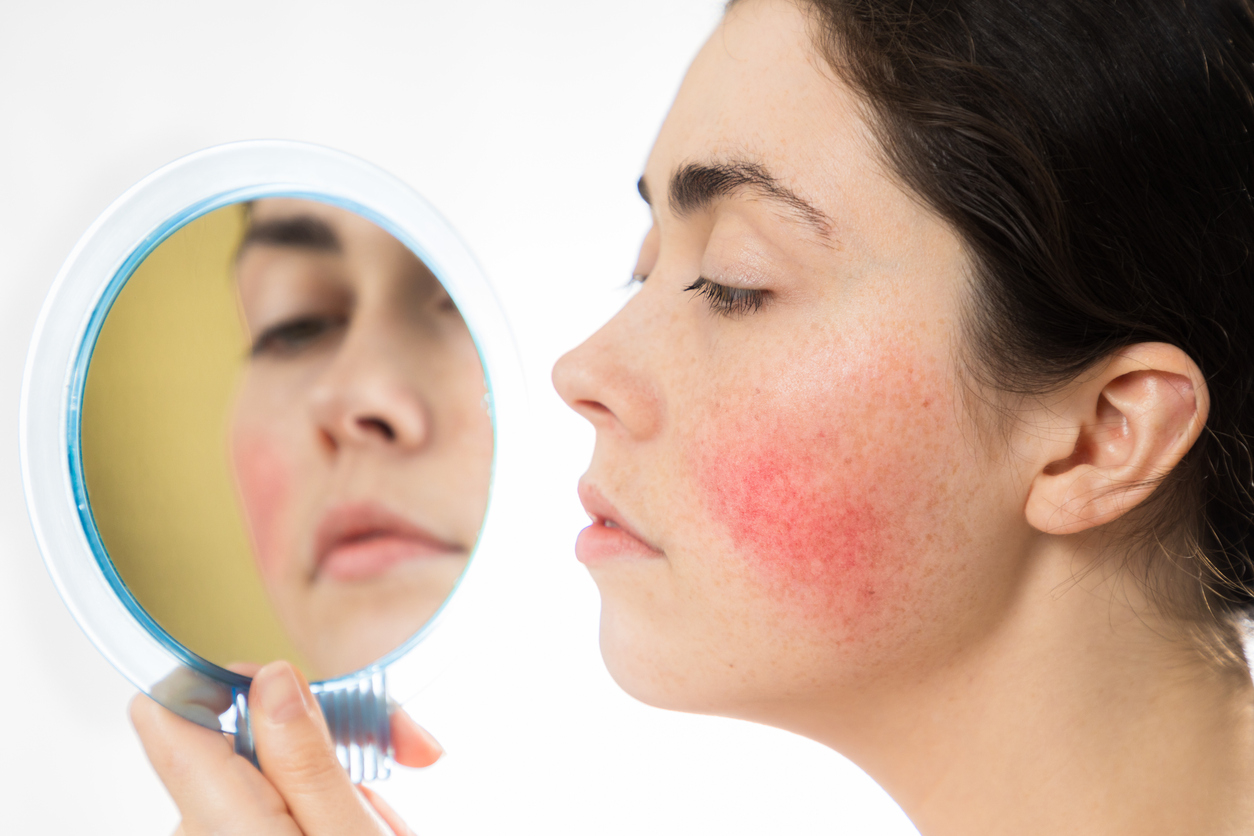Commitment + Clinical Leadership = Better Outcomes

Rosacea: Symptoms and Treatment
Rosacea is a common skin condition, affecting more than 14 million people in the United States. Rosacea is a chronic condition and there is currently no cure.1
Rosacea is more common in women, and it’s likely to show up after 30 years of age. However, anyone can be diagnosed with it.
Here are some facts about rosacea, its symptoms, and treatment options.
What is Rosacea?
Rosacea typically affects the nose, cheeks, and forehead. It often causes blushing, redness, and tiny bumps.2
Rosacea is known to cause flare-ups, which means people may experience symptoms for weeks or months at a time. After the flare-up, the symptoms will subside until another one occurs in the future.
Causes of Rosacea
Although there is no single cause of rosacea, researchers have concluded that there are a few factors that can contribute to someone having rosacea.1
- Genes. Many people who have rosacea have family members that have rosacea. Some researchers believe that rosacea is hereditary.
- Immune response. For individuals who have acne-like rosacea, scientists believe that their immune system is responding to a bacterium.
Other possible causes include a mite that lives on the skin or a bug that causes an infection in the intestines. However, scientists have not been able to prove either one of these insects as a direct cause of rosacea.
Certain factors that make individuals more likely to get rosacea include:
- Fair skin, blonde hair, and blue eyes
- Between the ages of 30 and 50
- Being a woman
- Have or have had severe acne
- Have family members with rosacea
- Smoking3
Symptoms of Rosacea
The most common symptoms of rosacea include:
- Redness on the face
- Facial flushing
- Small, red bumps
- Visible blood vessels
- Thickening of the skin on the nose
- Swollen skin
- Sensitive skin
- Stinging or burning sensation on the skin
- Dry skin
- Acne-like breakouts
Symptoms of rosacea will vary and will depend on the type and severity of the rosacea.4
Treatment for Rosacea
Visiting a dermatologist is how you can find the best treatments for your case. A dermatologist will review your medical history and symptoms to determine a diagnosis.
Once someone is diagnosed with rosacea, there are different treatment options. Since there is no cure, the treatments focus on managing symptoms and flare-ups.
The treatment options for rosacea will depend on an individual’s symptoms and severity. Taking care of the skin is the first step for treating rosacea because the skin can be sensitive and the condition is triggered by certain factors.
Here are some treatment options for those with rosacea:
- Topical medicines. For a mild case of rosacea, your doctor might suggest you use a topical cream or gel to reduce your symptoms. Some of these medicines work by constricting blood vessels or controlling the pimples caused by rosacea.
- Oral medicines. Your doctor may prescribe an oral medication for a slightly more severe case of rosacea to reduce the bumps and pimples on your skin.
- Laser therapy. Laser therapy can help treat enlarged blood vessels caused by rosacea. Because laser therapy is considered a cosmetic procedure, it’s typically not covered by insurance.5
Aside from the treatment options that your doctor can prescribe, there are many different actions you can take each day to reduce the symptoms of rosacea and avoid flare-ups.
- Identify triggers and avoid them. Pay close attention to what causes you to have a flare up. Any kind of activity or food that causes you to flush or break out can be a trigger for your rosacea. Common triggers for those with rosacea often include alcohol, spicy foods, hot showers or baths, stress, extremely hot or cold weather, sunlight, and intense exercise.3
- Wear sunscreen. Wearing sunscreen is extremely important to not only protect your skin, but it can also reduce rosacea symptoms such as redness.
- Find high-quality skin care products. Using high-quality skincare and taking care of your skin is one of the best things you can do. Be careful to avoid products that would irritate sensitive skin.
Saber Healthcare is an organization dedicated to providing consultant services to long-term care providers. This article is for informational purposes and is not meant to be seen as professional advice. Please consult with a medical expert before relying on the information provided.
Sources
- https://www.aad.org/public/diseases/rosacea/what-is/causes#:~:text=Rosacea%20is%20common.,and%2050%20years%20of%20age.
- https://www.aad.org/public/diseases/rosacea/what-is/overview.
- https://www.webmd.com/skin-problems-and-treatments/understanding-rosacea-basics.
- https://www.healthline.com/health/skin/rosacea.
- https://www.mayoclinic.org/diseases-conditions/rosacea/diagnosis-treatment/drc-20353820.
